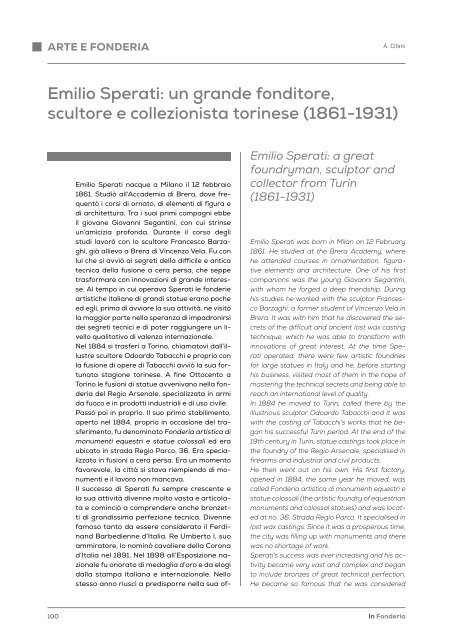In Fonderia 2 2024
Secondo numero del 2024 di In Fonderia
Secondo numero del 2024 di In Fonderia
You also want an ePaper? Increase the reach of your titles
YUMPU automatically turns print PDFs into web optimized ePapers that Google loves.
ARTE E FONDERIA<br />
A. Cifani<br />
Emilio Sperati: un grande fonditore,<br />
scultore e collezionista torinese (1861-1931)<br />
Emilio Sperati nacque a Milano il 12 febbraio<br />
1861. Studiò all’Accademia di Brera, dove frequentò<br />
i corsi di ornato, di elementi di figura e<br />
di architettura. Tra i suoi primi compagni ebbe<br />
il giovane Giovanni Segantini, con cui strinse<br />
un’amicizia profonda. Durante il corso degli<br />
studi lavorò con lo scultore Francesco Barzaghi,<br />
già allievo a Brera di Vincenzo Vela. Fu con<br />
lui che si avviò ai segreti della difficile e antica<br />
tecnica della fusione a cera persa, che seppe<br />
trasformare con innovazioni di grande interesse.<br />
Al tempo in cui operava Sperati le fonderie<br />
artistiche italiane di grandi statue erano poche<br />
ed egli, prima di avviare la sua attività, ne visitò<br />
la maggior parte nella speranza di impadronirsi<br />
dei segreti tecnici e di poter raggiungere un livello<br />
qualitativo di valenza internazionale.<br />
Nel 1884 si trasferì a Torino, chiamatovi dall’illustre<br />
scultore Odoardo Tabacchi e proprio con<br />
la fusione di opere di Tabacchi avviò la sua fortunata<br />
stagione torinese. A fine Ottocento a<br />
Torino le fusioni di statue avvenivano nella fonderia<br />
del Regio Arsenale, specializzata in armi<br />
da fuoco e in prodotti industriali e di uso civile.<br />
Passò poi in proprio. Il suo primo stabilimento,<br />
aperto nel 1884, proprio in occasione del trasferimento,<br />
fu denominato <strong>Fonderia</strong> artistica di<br />
monumenti equestri e statue colossali ed era<br />
ubicato in strada Regio Parco, 36. Era specializzato<br />
in fusioni a cera persa. Era un momento<br />
favorevole, la città si stava riempiendo di monumenti<br />
e il lavoro non mancava.<br />
Il successo di Sperati fu sempre crescente e<br />
la sua attività divenne molto vasta e articolata<br />
e cominciò a comprendere anche bronzetti<br />
di grandissima perfezione tecnica. Divenne<br />
famoso tanto da essere considerato il Ferdinand<br />
Barbedienne d’Italia. Re Umberto I, suo<br />
ammiratore, lo nominò cavaliere della Corona<br />
d’Italia nel 1891. Nel 1898 all’Esposizione nazionale<br />
fu onorato di medaglia d’oro e da elogi<br />
dalla stampa italiana e internazionale. Nello<br />
stesso anno riuscì a predisporre nella sua of-<br />
Emilio Sperati: a great<br />
foundryman, sculptor and<br />
collector from Turin<br />
(1861-1931)<br />
Emilio Sperati was born in Milan on 12 February<br />
1861. He studied at the Brera Academy, where<br />
he attended courses in ornamentation, figurative<br />
elements and architecture. One of his first<br />
companions was the young Giovanni Segantini,<br />
with whom he forged a deep friendship. During<br />
his studies he worked with the sculptor Francesco<br />
Barzaghi, a former student of Vincenzo Vela in<br />
Brera. It was with him that he discovered the secrets<br />
of the difficult and ancient lost wax casting<br />
technique, which he was able to transform with<br />
innovations of great interest. At the time Sperati<br />
operated, there were few artistic foundries<br />
for large statues in Italy and he, before starting<br />
his business, visited most of them in the hope of<br />
mastering the technical secrets and being able to<br />
reach an international level of quality.<br />
<strong>In</strong> 1884 he moved to Turin, called there by the<br />
illustrious sculptor Odoardo Tabacchi and it was<br />
with the casting of Tabacchi’s works that he began<br />
his successful Turin period. At the end of the<br />
19th century in Turin, statue castings took place in<br />
the foundry of the Regio Arsenale, specialised in<br />
firearms and industrial and civil products.<br />
He then went out on his own. His first factory,<br />
opened in 1884, the same year he moved, was<br />
called <strong>Fonderia</strong> artistica di monumenti equestri e<br />
statue colossali (the artistic foundry of equestrian<br />
monuments and colossal statues) and was located<br />
at no. 36, Strada Regio Parco. It specialised in<br />
lost wax castings. Since it was a prosperous time,<br />
the city was filling up with monuments and there<br />
was no shortage of work.<br />
Sperati’s success was ever increasing and his activity<br />
became very vast and complex and began<br />
to include bronzes of great technical perfection.<br />
He became so famous that he was considered<br />
100 <strong>In</strong> <strong>Fonderia</strong>














